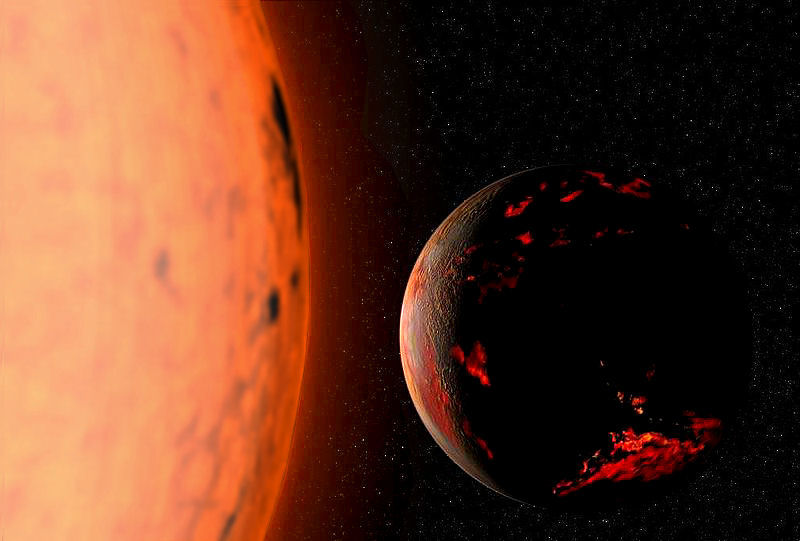|
Kepler-1520b
Kepler-1520b (initially published as KIC 12557548 b), is a confirmed exoplanet orbiting the K-type main sequence star Kepler-1520. It is located about 2,020 light-years (620 parsecs) away from Earth in the constellation of Cygnus. The exoplanet was found by using the transit method, in which the dimming effect that a planet causes as it crosses in front of its star is measured. The planet was previously proposed in 2012 when reports of its host star recorded drops in its luminosity varying from 0.2% to 1.3%, which indicated a possible planetary companion rapidly disintegrating. In 2015, the planetary nature of the cause of the dips was finally verified. It is expected to disintegrate in about 40–400 million years. Physical characteristics Mass, radius, and temperature The mass of Kepler-1520b is unknown however modeling of the mass loss rate of the planet indicates that the planet cannot be more massive than about 2% the mass of the Earth (less than double the mass of the Moon) ... [...More Info...] [...Related Items...] OR: [Wikipedia] [Google] [Baidu] |
Kepler-1520
Kepler-1520 (initially published as KIC 12557548) is a K-type main-sequence star located in the constellation Cygnus. The star is particularly important, as measurements taken by the ''Kepler'' spacecraft indicate that the variations in the star's light curve cover a range from about 0.2% to 1.3% of the star's light being blocked. This indicates that there may be a rapidly disintegrating planet, a prediction not yet conclusively confirmed, in orbit around the star, losing mass at a rate of 1 Earth mass every billion years. The planet itself is about 0.1 Earth masses, or just twice the mass of Mercury, and is expected to disintegrate in about 100-200 million years. The planet orbits its star in just 15.7 hours, at a distance only two stellar diameters away from the star's surface, and has an estimated effective temperature of about 2255 K. The orbital period of the planet is one of the shortest ever detected in the history of the extrasolar planet search. In 2016, the planet ... [...More Info...] [...Related Items...] OR: [Wikipedia] [Google] [Baidu] |
Sublimation (phase Transition)
Sublimation is the transition of a substance directly from the solid to the gas state, without passing through the liquid state. Sublimation is an endothermic process that occurs at temperatures and pressures below a substance's triple point in its phase diagram, which corresponds to the lowest pressure at which the substance can exist as a liquid. The reverse process of sublimation is deposition or desublimation, in which a substance passes directly from a gas to a solid phase. Sublimation has also been used as a generic term to describe a solid-to-gas transition (sublimation) followed by a gas-to-solid transition ( deposition). While vaporization from liquid to gas occurs as evaporation from the surface if it occurs below the boiling point of the liquid, and as boiling with formation of bubbles in the interior of the liquid if it occurs at the boiling point, there is no such distinction for the solid-to-gas transition which always occurs as sublimation from the surface. ... [...More Info...] [...Related Items...] OR: [Wikipedia] [Google] [Baidu] |
Kelvin Scale
The kelvin, symbol K, is the primary unit of temperature in the International System of Units (SI), used alongside its prefixed forms and the degree Celsius. It is named after the Belfast-born and University of Glasgow-based engineer and physicist William Thomson, 1st Baron Kelvin (1824–1907). The Kelvin scale is an absolute thermodynamic temperature scale, meaning it uses absolute zero as its null (zero) point. Historically, the Kelvin scale was developed by shifting the starting point of the much-older Celsius scale down from the melting point of water to absolute zero, and its increments still closely approximate the historic definition of a degree Celsius, but since 2019 the scale has been defined by fixing the Boltzmann constant to be exactly . Hence, one kelvin is equal to a change in the thermodynamic temperature that results in a change of thermal energy by . The temperature in degree Celsius is now defined as the temperature in kelvins minus 273.15, meaning t ... [...More Info...] [...Related Items...] OR: [Wikipedia] [Google] [Baidu] |
Exoplanets Discovered In 2016
An exoplanet or extrasolar planet is a planet outside the Solar System. The first possible evidence of an exoplanet was noted in 1917 but was not recognized as such. The first confirmation of detection occurred in 1992. A different planet, initially detected in 1988, was confirmed in 2003. There are many methods of detecting exoplanets. Transit photometry and Doppler spectroscopy have found the most, but these methods suffer from a clear observational bias favoring the detection of planets near the star; thus, 85% of the exoplanets detected are inside the tidal locking zone. In several cases, multiple planets have been observed around a star. About 1 in 5 Sun-like starsFor the purpose of this 1 in 5 statistic, "Sun-like" means G-type star. Data for Sun-like stars was not available so this statistic is an extrapolation from data about K-type stars. have an " Earth-sized"For the purpose of this 1 in 5 statistic, Earth-sized means 1–2 Earth radii. planet in the habitab ... [...More Info...] [...Related Items...] OR: [Wikipedia] [Google] [Baidu] |
HD 189733 B
HD 189733 b is an exoplanet approximately away from the Solar System in the constellation of Vulpecula. Astronomers in France discovered the planet orbiting the star HD 189733 on October 5, 2005, by observing its transit across the star's face. With a mass 16.2% higher than that of Jupiter and a radius 13.8% greater, HD 189733 b orbits its host star once every 2.2 days at an orbital speed of , making it a hot Jupiter with poor prospects for extraterrestrial life. The closest transiting hot Jupiter to Earth, HD 189733 b is a subject of extensive atmospheric examination. Accordingly, scientists have extensively studied the exoplanet's atmosphere with high- and low-resolution instruments, both from the ground and space. Researchers have found that the planet has an unusual rain of molten glass. HD 188733 b was also the first exoplanet to have its thermal map constructed (possibly to be detected through polarimetry), its overall color determined (deep blue), transit in the X-ray s ... [...More Info...] [...Related Items...] OR: [Wikipedia] [Google] [Baidu] |
William Herschel Telescope
The William Herschel Telescope (WHT) is a optical/near-infrared reflecting telescope located at the Roque de los Muchachos Observatory on the island of La Palma in the Canary Islands, Spain. The telescope, which is named after William Herschel, the discoverer of the planet Uranus, is part of the Isaac Newton Group of Telescopes. It is funded by research councils from the United Kingdom, the Netherlands and Spain. At the time of construction in 1987, the WHT was the third largest single optical telescope in the world.The BTA-6 (6.0 m) and Hale telescope (5.1 m) were both larger; the Multiple Mirror Telescope also had a larger collecting area but did not have a single primary mirror It is currently the second largest in Europe,The neighbouring Gran Telescopio Canarias (10.4 m) overtook the WHT in 2009 to become the largest in Europe and was the last telescope constructed by Grubb Parsons in their 150-year history. The WHT is equipped with a wide range of instrum ... [...More Info...] [...Related Items...] OR: [Wikipedia] [Google] [Baidu] |
Positive Feedback Loop
Positive feedback (exacerbating feedback, self-reinforcing feedback) is a process that occurs in a feedback loop which exacerbates the effects of a small disturbance. That is, the effects of a perturbation on a system include an increase in the magnitude of the perturbation. That is, ''A produces more of B which in turn produces more of A''.Keesing, R.M. (1981). Cultural anthropology: A contemporary perspective (2nd ed.) p.149. Sydney: Holt, Rinehard & Winston, Inc. In contrast, a system in which the results of a change act to reduce or counteract it has negative feedback. Both concepts play an important role in science and engineering, including biology, chemistry, and cybernetics. Mathematically, positive feedback is defined as a positive loop gain around a closed loop of cause and effect. That is, positive feedback is in phase with the input, in the sense that it adds to make the input larger. Positive feedback tends to cause system instability. When the loop gain is pos ... [...More Info...] [...Related Items...] OR: [Wikipedia] [Google] [Baidu] |
Saul Rappaport
Saul Rappaport is a professor emeritus of physics at the Massachusetts Institute of Technology. Rappaport became Assistant Professor in the MIT Department of Physics in 1969 and became a full professor in 1981. From 1993 to 1995, he was head of the Astrophysics Division. He received his A.B. from Temple University in 1963 and his Ph.D. from MIT in 1968. His main research interest is in binary systems containing collapsed stars—white dwarfs, neutron stars (including pulsars), and black holes. He was elected a Fellow of the American Physical Society in 1989 ''"for major contributions to our understanding of the evolution of binary stellar systems containing a compact member and for the determination of the masses of neutron stars"'' Selected publications Some of his publications in the ''Astrophysical Journal ''The Astrophysical Journal'', often abbreviated ''ApJ'' (pronounced "ap jay") in references and speech, is a peer-reviewed scientific journal of astrophysics and astr ... [...More Info...] [...Related Items...] OR: [Wikipedia] [Google] [Baidu] |
Future Of The Earth
The biological and geological future of Earth can be extrapolated based on the estimated effects of several long-term influences. These include the chemistry at Earth's surface, the cooling rate of the planet's interior, the gravitational interactions with other objects in the Solar System, and a steady increase in the Sun's luminosity. An uncertain factor is the pervasive influence of technology introduced by humans, such as climate engineering, which could cause significant changes to the planet. For example, the current Holocene extinction is being caused by technology, and the effects may last for up to five million years. In turn, technology may result in the extinction of humanity, leaving the planet to gradually return to a slower evolutionary pace resulting solely from long-term natural processes. Over time intervals of hundreds of millions of years, random celestial events pose a global risk to the biosphere, which can result in mass extinctions. These include ... [...More Info...] [...Related Items...] OR: [Wikipedia] [Google] [Baidu] |
Astronomical Unit
The astronomical unit (symbol: au, or or AU) is a unit of length, roughly the distance from Earth to the Sun and approximately equal to or 8.3 light-minutes. The actual distance from Earth to the Sun varies by about 3% as Earth orbits the Sun, from a maximum ( aphelion) to a minimum ( perihelion) and back again once each year. The astronomical unit was originally conceived as the average of Earth's aphelion and perihelion; however, since 2012 it has been defined as exactly (see below for several conversions). The astronomical unit is used primarily for measuring distances within the Solar System or around other stars. It is also a fundamental component in the definition of another unit of astronomical length, the parsec. History of symbol usage A variety of unit symbols and abbreviations have been in use for the astronomical unit. In a 1976 resolution, the International Astronomical Union (IAU) had used the symbol ''A'' to denote a length equal to the ast ... [...More Info...] [...Related Items...] OR: [Wikipedia] [Google] [Baidu] |
Mercury (planet)
Mercury is the smallest planet in the Solar System and the closest to the Sun. Its orbit around the Sun takes 87.97 Earth days, the shortest of all the Sun's planets. It is named after the Roman god ' ( Mercury), god of commerce, messenger of the gods, and mediator between gods and mortals, corresponding to the Greek god Hermes (). Like Venus, Mercury orbits the Sun within Earth's orbit as an inferior planet, and its apparent distance from the Sun as viewed from Earth never exceeds 28°. This proximity to the Sun means the planet can only be seen near the western horizon after sunset or the eastern horizon before sunrise, usually in twilight. At this time, it may appear as a bright star-like object, but is more difficult to observe than Venus. From Earth, the planet telescopically displays the complete range of phases, similar to Venus and the Moon, which recurs over its synodic period of approximately 116 days. The synodic proximity of Mercury to Earth makes Mercury ... [...More Info...] [...Related Items...] OR: [Wikipedia] [Google] [Baidu] |
Apparent Magnitude
Apparent magnitude () is a measure of the brightness of a star or other astronomical object observed from Earth. An object's apparent magnitude depends on its intrinsic luminosity, its distance from Earth, and any extinction of the object's light caused by interstellar dust along the line of sight to the observer. The word ''magnitude'' in astronomy, unless stated otherwise, usually refers to a celestial object's apparent magnitude. The magnitude scale dates back to the ancient Roman astronomer Claudius Ptolemy, whose star catalog listed stars from 1st magnitude (brightest) to 6th magnitude (dimmest). The modern scale was mathematically defined in a way to closely match this historical system. The scale is reverse logarithmic: the brighter an object is, the lower its magnitude number. A difference of 1.0 in magnitude corresponds to a brightness ratio of \sqrt /math>, or about 2.512. For example, a star of magnitude 2.0 is 2.512 times as bright as a star of magnitude 3.0 ... [...More Info...] [...Related Items...] OR: [Wikipedia] [Google] [Baidu] |








